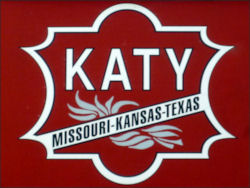 Sadly, there is no “Katy Trail” in Kansas, but judging by the name of the railroad the trail is based on — the M-K-T (Missouri, Kansas & Texas Railway) — there should be!
Sadly, there is no “Katy Trail” in Kansas, but judging by the name of the railroad the trail is based on — the M-K-T (Missouri, Kansas & Texas Railway) — there should be!
(As an aside, isn’t it odd that the most famous portion of the Katy Trail is in Missouri, while “Katy” — “K.T.” — stands for “Kansas” and “Texas”?)
Here’s a listing of most of the railroad sections in Kansas that were either built by the MKT, or would ultimately be owned by the MKT:
| Section | Built | Miles | Cities | Current Status |
|---|---|---|---|---|
| Junction City to Chetopa | 1869-70 by the MKT | 182.50 | Junction City, Council Grove, Americus, Emporia, Burlington, Neosho Falls, Chanute, Parsons, Labette, Oswego, Chetopa | Lost from Council Grove to Parsons (~150 miles), still in use south of Parsons |
| Parsons to Missouri State Line | 1871 by the MKT | 53.50 | Parsons, St. Paul, Walnut, Fort Scott | Lost |
| Paola to Missouri State Line | 1872 by the MKT | 15.00 | Paola, Somerset, Lousiburg | Abandoned in 1958, Lost |
| Paola to Parsons | 1886-88 by the Kansas City & Pacific Railroad | 93.75 | Paola, Parker, Centerville, Kincaid, Moran, Elsmore, Erie, Parsons | Still in use |
| Parsons to Coffeyville | 1887 by the Parsons & Pacific Railroad | 31.25 | Parsons, Mound Valley, Angola, Coffeyville | Lost |
| Coffeyville to Oklahoma State Line | 1888 by the MKT | 5.00 | Coffeyville | Still in use |
| Cherokee Junction to Mineral | 1895 by the Southwestern Mineral Railway | 17.00 | Labette, West Mineral | Lost |
| West Mineral to Missouri State Line | 1901 by the Missouri, Kansas & Northwestern Railroad | 23.20 | West Mineral, Columbus, Galena | Lost between West Mineral & Columbus (~9 miles); still in use between Columbus & state line |
| Moran to Iola | 1901-02 by the Fort Scott, Iola & Western Railway | 15.20 | Moran, La Harpe, Iola | Lost |
By my count, that’s roughly 290 miles of railroad that has been abandoned, and lost forever.
What’s heartbreaking is that, if you look at the routes using satellite maps, the right-of-way is still clearly visible as treelines and off-grid roads, broken by missing bridges and plowed fields reclaiming the former rail line.
For example, here’s an overhead view of the town of Somerset, with the rail corridor being the curving line of trees running from the northeast to the in the west. The track is long gone, and you can see that houses have actually been built on the old right-of-way, but the route is otherwise unused:
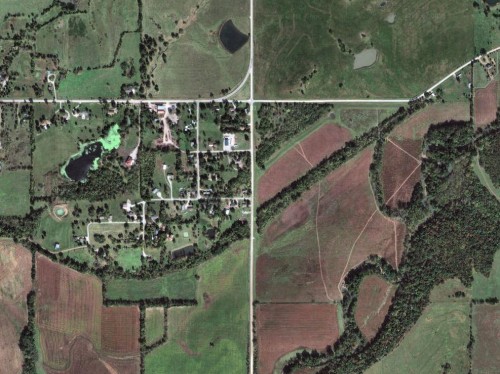
From the ground, the route is often harder to make out, but in a few places, the old line is still visible, as in this photo, also from Somerset, KS:
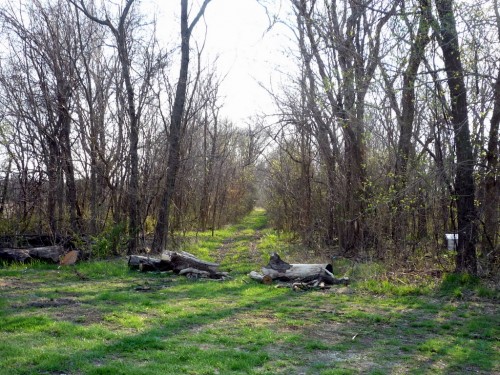
Looking at this makes me sad, particularly as this line ran from Paola to Sedalia, Missouri. If it had been saved, we could have connected directly to the Katy Trail State Park at Sedalia.
Likewise with the line running from Parsons to Fort Scott, which was the MKT “main line”, running through Nevada, MO and on to Clinton, MO — currently the western terminus of the Katy Trail.
But the longest length of lost corridor, from Junction City to Parsons, is perhaps the most regrettable of all — 150 miles of rail-trail running along the Neosho River and through the heart of the Flint Hills, connecting to the Flint Hills Nature Trail at Council Grove. It would have been an amazing resource for Kansas.
Of course, most of these lines were abandoned long before the National Trails System Act of 1983 was enacted to allow no-longer-active rail corridors to be converted to trails — railbanked — to hold the right-of-way in case the country ever needed to rebuild the railroads.
Here’s a very rough map of the MKT in the state of Kansas:
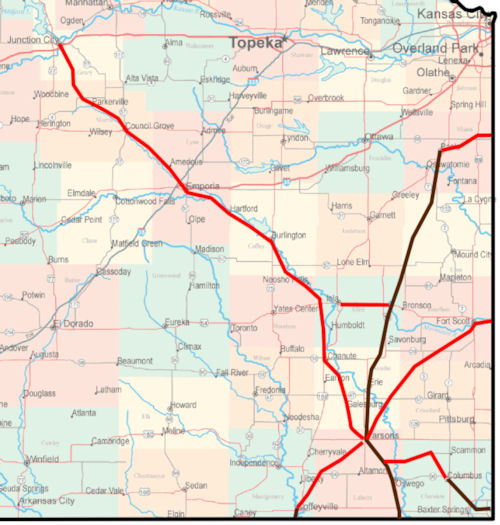
The red lines are what has been lost; the brown lines still carry railroad traffic.
And of course there are hundreds of miles of additional, non-MKT, rail lines that have disappeared over time throughout the state of Kansas. Opportunities lost.
Here are some additional links for researching the MKT railroad:
- KansasHeritage.org – The Katy Railroad in Kansas
- The “M” in the MKT – A detailed history of the MKT in Missouri.
- KatyRailroad.org – Katy Railroad Historical Society
And finally, there is a bit of the old MKT alive in Kansas. Here is an engine used by the Midland Railway, an excursion train that runs out of Baldwin City, Kansas (on non-MKT tracks, ironically):
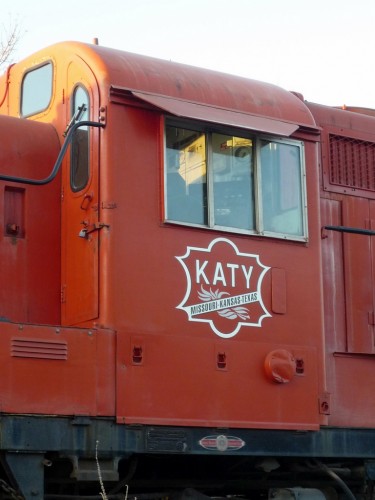
Post tags: Rail Trail



Yes there is a Katy trail in Kansas, I am not sure of the routes that might have been abandoned, but the original Katy hub was in Parsons Ks. The annual “Katy Days” celebration is there with an excellent duathlon. I will do some digging and see if there is any old abandoned routes. During the coal mining days in the southeast Ks area there was a heavy rail presence. Stands to mind there are rails that could be made into trails.